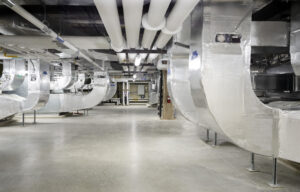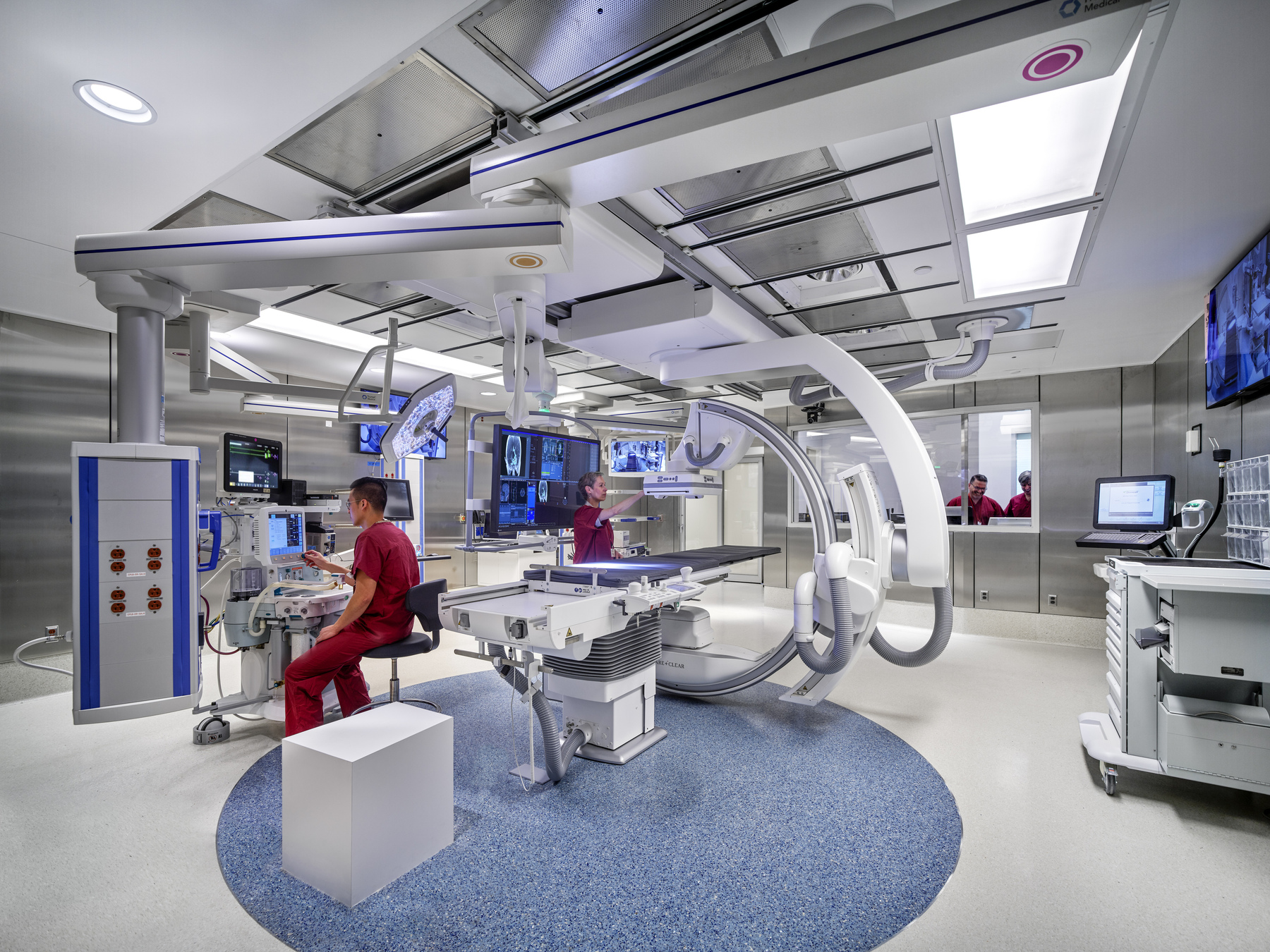Photo: Resilience is not optional for healthcare campuses. Hospitals must stay operational during earthquakes, storms, and heat waves, which means redundancy isn’t a luxury—it’s essential. | Photo Credit: Halkin Mason Photography
By Dennis Potter
As climate change accelerates and inflation drives construction costs, healthcare institutions are at a crossroads. Their facilities must be resilient to extreme weather and deliver uninterrupted care, even as these organizations face mounting pressure to decarbonize. The result is a high-stakes balancing act, where every infrastructure decision must weigh environmental responsibility, operational reliability and financial feasibility.
For hospitals and health systems, the stakes couldn’t be higher. These critical services must function regardless of power outages, water disruptions, or heat waves. But with aging systems, deferred maintenance, and ever-tighter budgets, executing a Climate Action Plan isn’t just complex—it’s daunting. Yet healthcare leaders aren’t backing down. Many are finding that, with the right strategies, tools and mindset, it is possible to pursue sustainability without compromising care or budgets. To navigate these competing demands, healthcare leaders are turning to data-driven strategies that allow them to act with precision and purpose—starting with how they execute their Climate Action Plans.
Rethinking Execution: Modeling for Impact Without Disruption

Photo Credit: Ballinger
Many institutions have committed to reducing their carbon footprint, but execution often understandably stalls when faced with budget constraints and operational risks. In healthcare, where uptime is non-negotiable, simply flipping the switch on new systems is rarely an option. The solution? Data-driven modeling. Sophisticated predictive analysis tools allow healthcare systems to simulate building loads, energy usage patterns, and climate conditions across campuses. This modeling can forecast the CO₂ impact and operational costs of transitioning to technologies like heat pumps for central heating and cooling. By precisely timing loads and identifying energy overlaps, facilities teams can optimize system performance and avoid disruption.
These tools are invaluable for phased implementation strategies. They allow decision-makers to chart a path to carbon reduction that aligns with patient care priorities and funding realities. The result is a smarter, more tailored plan demonstrating environmental and financial payback long before full deployment. However, optimizing carbon reduction is only part of the equation; to truly future-proof infrastructure, healthcare facilities must also fortify themselves against increasing climate-related changes.
Building Resilient Systems: Multipath Energy and Water Infrastructure
Resilience is not optional for healthcare campuses. Hospitals must stay operational during earthquakes, storms, and heat waves, which means redundancy isn’t a luxury—it’s essential.
Modern resiliency strategies begin with diversification. Hospitals are designing infrastructure with multiple sources and pathways for both energy and water. For example, when a single electrical feed or water main is disrupted, backup systems can kick in without missing a beat. This can include everything from dual electrical feeds and microgrids to water storage systems or alternate utility pathways.
An interrupted water supply means toilets can’t be flushed and cooling capacity is at risk. A particularly promising innovation in water resiliency is the reuse of non-potable water. By separating potable from non-potable systems and implementing wastewater reclamation, hospitals can ensure a backup water supply for systems like steam generation, evaporative cooling, and toilet flushing—areas where drinking-quality water is unnecessary. These systems reduce dependency on city infrastructure while helping municipalities by reducing stress in their sewer systems. This integrated, multi-source infrastructure isn’t just about safeguarding operations—it’s also a step toward greater autonomy and long-term sustainability. While resilience depends on diversified systems, decarbonization often requires a different transformation that involves rethinking how healthcare campuses generate and distribute heat.
Electrification Without Compromise
Decarbonization often hinges on electrification, and healthcare campuses are no exception. But fully electrifying older buildings—especially those reliant on steam for heating—can be complex and costly. The good news is that new-generation heat pump technology is closing that gap. Unlike older systems, which struggled to produce heat in cold temperatures, today’s heat pumps can deliver hot water over 140 degrees Fahrenheit and maintain performance even when outdoor temperatures drop into the teens.
This means healthcare facilities can retrofit existing buildings without massive infrastructure changes. Simultaneous heating and cooling loads across campuses can be leveraged for better performance, with heat being moved from one stream to another. In many cases, one kilowatt of input energy can yield five to six kilowatts of useful thermal energy, significantly improving efficiency. It’s a technical solution with wide-reaching benefits: reduced fossil fuel use, smaller carbon footprints, and systems that operate reliably across seasonal extremes. Still, even the most advanced technologies face a hard reality: healthcare institutions must implement these changes amid escalating infrastructure costs and shrinking capital budgets.
Watch for Part II of this article, which will focus on budgeting in the age of inflation and other key takeaways, on hconews.com Oct. 16.
Dennis Potter, PE, LEED AP, is a Senior Principal at Ballinger, an integrated design practice based in Philadelphia.


